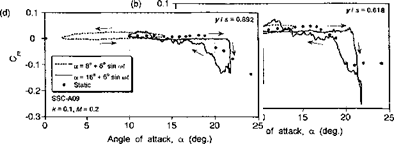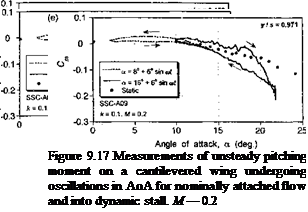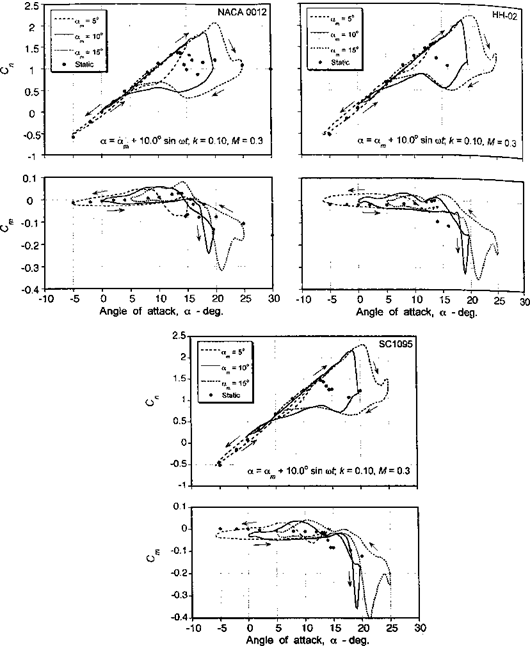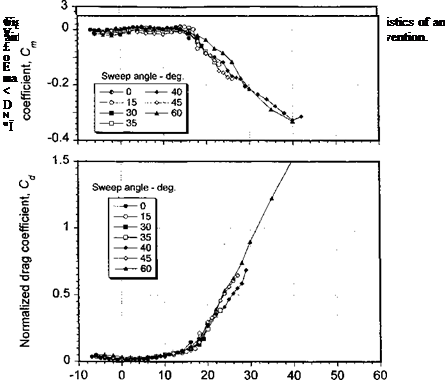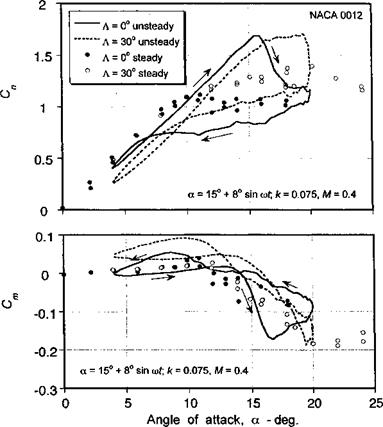The onset of dynamic stall limits the capabilities of all helicopters. The idea of using some type of passive or active means of delaying the onset of dynamic stall is not a new one. The benefits include a reduction in rotor loads and substantial increases in the forward flight speed and/or the maneuver flight envelope. This will increase the utility of both civilian and military helicopters. Methods that have been proposed include active cyclic pitch control (such as higher harmonic control), the active actuation of leading – edge or trailing edge flaps, and direct flow control. Chandrasekhara et al. (1998) propose a dynamically deforming leading edge airfoil shape for dynamic stall control. See also Chandrasekhara et al. (1999), Martin et al. (2003), and Geissler et al. (2004) for a review of some “leading edge” based concepts and their theoretical effectiveness. Feszty et al. (2003) suggest another concept based on a trailing edge flap. Some other ideas of flow control have been introduced previously in Section 7.10.
It has been suggested by several workers, including Lorber et al. (2000), that active flow control can play a future role in delaying the onset of dynamic stall or even avoiding stall altogether on helicopter rotors. Katz et al. (1989), Seifert & Pack (1999), and Greenblatt & Wyganaski (1999) have examined different methods of active boundary layer control to delay stall onset. While the fluid mechanisms are not completely understood, the concept involves periodic flow excitation at low amplitude, and enough to energize the boundary layer and delay the onset of flow separation. This periodic excitation is provided by a mechanical element that injects an unsteady jet of fluid or through suction and/or blowing. These devices are often referred to as “zero mass synthetic jets” or “direct synthetic jets.” Candidate mechanisms to provide this flow include piezoelectric ceramics, fluidics, electromechanical devices, and plasma actuation. However, all devices involve weight, power, and cost penalties. For a helicopter rotor, they also need to operate in a high centrifugal force field over a wide range of environmental conditions. This raises many questions about their design for robustness and long reliability when applied to a rotor blade.
Feasibility studies of using such active flow control devices has been conducted experimentally by Lorber et al. (2000) using 2-D airfoils. This technique has shown an effectiveness in delaying dynamic stall onset by up to 3° in AoA at low Mach numbers, although it was found to be less effective at higher Mach numbers. Thus far, the devices have not been applied to an actual helicopter rotor. Parallel computational studies of active flow devices have allowed an examination of the flow physics and how they might be controlled to maximize their effectiveness. Both open loop and closed loop (sensing) strategies have been examined. Claims of more than 20% in payload and 35% in range for a medium size helicopter seem optimistic based on extrapolating the existing computational results. Full – scale helicopter rotor experiments will need to be conducted to properly demonstrate if such claims can indeed be realized with active flow control for dynamic stall allieviation.
9.6 Chapter Review
flutter. Although dynamic stall can occur at various regions over the rotor disk, depending on the flight condition, it usually occurs on the retreating side of the disk during highspeed forward flight or during maneuvers such as tight turns or pull-ups. Therefore, the consideration of dynamic stall phenomenon represents a necessary refinement in the rotor design process and will more accurately define the operational and performance boundaries of the modern helicopter.
While the prediction of the conditions for dynamic stall onset and the subsequent effects of dynamic stall clearly forms an essential part of any rotor design process, it is not a problem that is yet fully understood, nor is it easily predicted. For engineering analyses, the modeling of dynamic stall still remains a particularly challenging problem. This is mainly because of the need to balance physical accuracy with computational efficiency and/or the need to formulate a model of dynamic stall in a particular mathematical form. To this end, a number of semi-empirical models have been developed for use in rotor design work, most of which have their root in classical unsteady thin-airfoil theory. A brief discussion of these
Scull-СґПрІПСаІ methods haS uCCfi presented, along With a demonstration of their general capabilities in predicting the unsteady airloads during dynamic stall. Generally, predictions are good when measurements are available for validation or empirical refinement of the model, but their capabilities for general airfoil shapes and for completely arbitrary variations of AoA and Mach number are less certain. Future research will almost certainly devise more capable and better validated engineering models of the dynamic stall problem until such time that CFD methods capable of modeling 3-D, compressible, unsteady, separated flows become more practical to use on a routine basis within rotor codes.
Other factors that may influence the phenomenon of dynamic stall on a rotor have also been discussed. These include compressibility effects, airfoil shape, sweep angle, unsteady onset velocity effects, and 3-D effects. It appears that whereas the qualitative characteristics of dynamic stall are similar at all Mach numbers, there are subtle quantitative differences in the unsteady airloads that may be difficult to represent accurately within the context of engineering models. The effect of airfoil shape on the problem of dynamic stall is still not fully understood. It appears that airfoils designed for high values of static maximum lift
Ч1МІ1 ПІСЛ СІІЛІї; К1 ҐТІ"* 1ГПІ1ШГ Л-р lift in fVlO ГІ1/ПО Ш1 Г* ЛОГО U ЛИ701Г0Г -if ol СЛ О ППО О ГС that thft
win ciiow onv w ui£ii v aiuvo ш im. in uiw ujiiaiinv/ ^uov. uuwvyvi, it awv appv/ux о umt,
the 2-D case when corrected for the additional quasi-steady induced effects associated with finite span.
There remain many uncertainties in the prediction (and possibly control) of dynamic stall and also in the proper validation of predictions with measured airloads on the rotor. This is because of the need to also define accurately the blade motions and elastic deformation of the rotor blades, as well as the aerodynamic environment on the rotor in terms of induced AoA and induced velocity field. In regard to the latter, the inflow models discussed in Section 3.5.2 often prove inadequate because of the strong local induced velocity variations produced by discrete tip vortices in the rotor wake. This latter problem is considered next in Chapter 10. The problem of modeling the rotor wake, however, is just as formidable as the dynamic stall problem, perhaps even more so. The overall level of rotor analysis capability is only as strong as the weakest link in the modeling chain. Until it becomes possible to model all aerodynamic aspects of the rotor problem and improve on the existing deficiencies and uncertainties that are present in the predictive models, helicopter design cycle times will continue to be long and costs will remain high. Finally, the possibilities of actively delaying the onset of dynamic stall or controlling its adverse effects has been reviewed. The field seems ripe with many future opportunities in basic and applied research, with significant potential long-term payoffs in terms of improved helicopter performance.











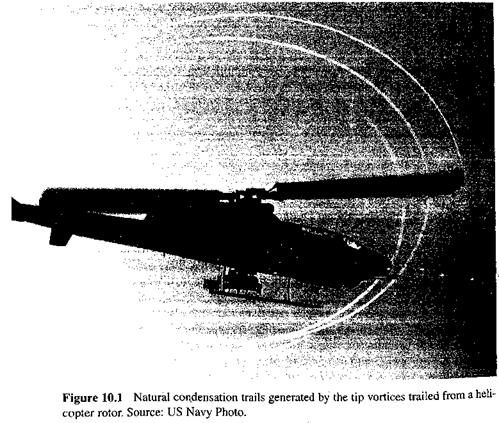



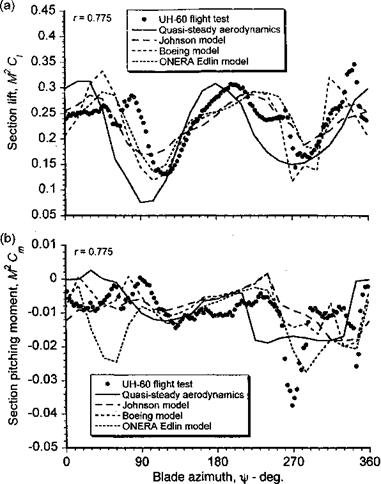

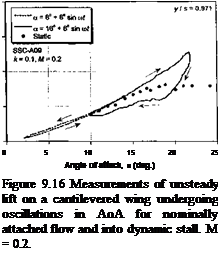 (3) 2
(3) 2